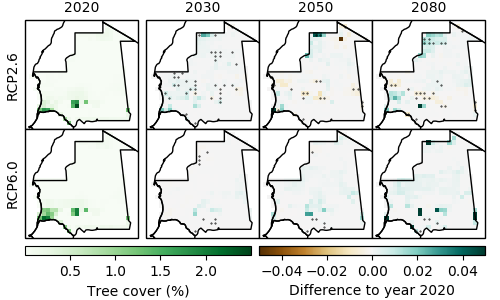Mauritania: Ecosystems
Climate change is expected to have a significant influence on the ecology and distribution of tropical ecosystems, though the magnitude, rate and direction of these changes are uncertain [27]. With rising temperatures and increased frequency and intensity of droughts, wetlands and riverine systems are increasingly at risk of being converted to other ecosystems, with plant populations being succeeded and animals losing habitats. Increased temperatures and droughts can also impact succession in forest systems while concurrently increasing the risk of invasive species, all of which affect ecosystems. In addition to these climate drivers, low agricultural productivity and population growth might motivate further agricultural expansion resulting in increased deforestation, land degradation and forest fires, all of which will impact animal and plant biodiversity.
Species richness

Model projections of species richness (including amphibians, birds and mammals) and tree cover for Mauritania are shown in Figure 16 and 17, respectively. The models applied for this analysis show particularly strong agreement on the development of species richness: Under RCP2.6, south-western Mauritania is expected to gain up to 30 % of animal species due to climate change. This trend will intensify under RCP6.0, in addition to a decrease of up to 50 % in the south-east of the country (Figure 16).
Tree cover

With regard to tree cover, model results are very uncertain and of low magnitude under both RCPs (Figure 17), which could also relate to the fact that tree cover in Mauritania is generally sparse. Overall, no reliable estimations on the development of tree cover can be made.
It is important to keep in mind that the model projections exclude any impacts on biodiversity loss from human activities such as land use, which have been responsible for significant losses of global biodiversity in the past, and are expected to remain its main driver in the future [28]. In recent years, Mauritania’s vegetation has experienced profound disturbances due to population pressure and increasing demand for pastures, agricultural land and firewood, leading to high rates of deforestation [25]. The country has lost 86 000 ha of forest cover in the period from 2001 to 2016, which is equivalent to a 28 % decrease [2].
References
[2] World Bank, “World Bank Open Data,” 2019. Online available: https://data.worldbank.org [Accessed: 31-Jan-2020].
[25] N. K. Dia, A. A. Bayod-Rújula, N. Mamoudou, M. Diallo, C. S. Ethmane, and B. O. Bilal, “Energy Context in Mauritania,” Energy Sources, Part B Econ. Plan. Policy, vol. 12, no. 2, pp. 182–190, 2017.
[27] T. M. Shanahan, K. A. Hughen, N. P. McKay, J. T. Overpeck, C. A. Scholz, W. D. Gosling, C. S. Miller, J. A. Peck, J. W. King, and C. W. Heil, “CO2 and Fire Influence Tropical Ecosystem Stability in Response to Climate Change,” Nat. Publ. Gr., no. July, pp. 1–8, 2016.
[28] IPBES, “Report of the Plenary of the Intergovernmental Science-Policy Platform on Biodiversity and Ecosystem Services on the Work of Its Seventh Session,” n.p., 2019.


